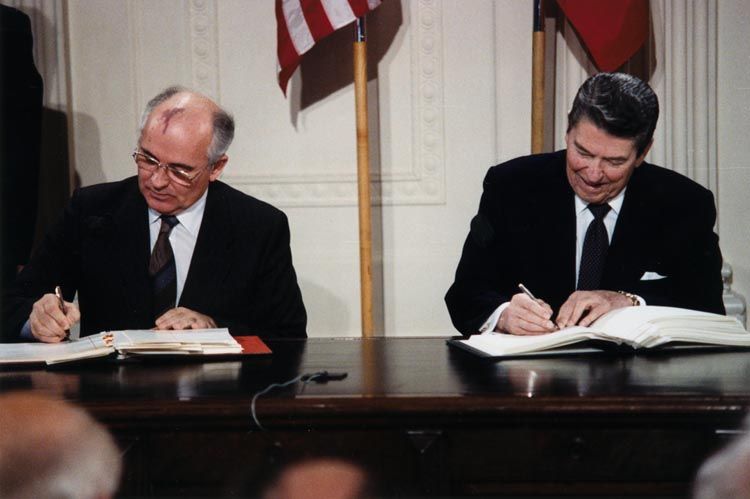Shooting down the Star Wars myth
By Pavel Podvig | April 30, 2013

It has been 30 years since US President Ronald Reagan called for development of a missile defense system that was supposed to make nuclear weapons "impotent and obsolete." The Strategic Defense Initiative (SDI) launched by Reagan's famous "Star Wars" speech in March 1983 has survived to the present day, but with ever-lower expectations. Long gone is the vision of a missile defense system that could "counter the awesome Soviet missile threat." That has been replaced with the hope that a few dozen interceptors with a spotty test record will protect the United States from an attack by a few nonexistent missiles from North Korea or Iran. What has not changed is the controversy that surrounds missile defense and its role in the nuclear age.
SDI shaped the waning years of the Cold War and set in motion developments that still dominate — and indeed poison — efforts to stop the spread of nuclear weapons. A program as ambitious and politically charged as SDI was bound to create a rich mythology, and in fact quite a bit of misinformation from its early days still persists. One reason: Until quite recently, almost no one had a good picture of the Soviet side of the story. Most of the Soviet memoirs and testimonies were quite ambiguous and left plenty of room for ideologically driven interpretation.
The situation changed after researchers gained access to Soviet archival documents from the time. David Hoffman first described them in his prize-winning book The Dead Hand, which questioned the role of SDI in ending the Cold War. I also undertook a detailed and technical look at the documents in an attempt to reconstruct the Soviet response to SDI. As I conclude in a new working paper, far from hastening the arrival of a more peaceful era, Star Wars made the transition from arms race to nuclear disarmament much more difficult that it needed to be.
One common misperception holds that Washington's advanced missile defense system helped bring Moscow to the negotiating table and make it agree to dramatic reductions in its nuclear arsenal. Indeed, at the Reykjavik summit in 1986 between Reagan and Soviet leader Mikhail Gorbachev, Gorbachev appeared willing to surrender the Soviet ballistic missile force (and agree to complete nuclear disarmament) in exchange for limits on US missile defense. The deal fell through when Reagan refused to give up his favorite program.
But while this episode is often presented as proof that the Soviet Union feared Star Wars would give the United States superiority in the nuclear arms race, the documents show that Gorbachev insisted on curbing the program for different reasons. He was serious about ending the arms race and reducing nuclear arsenals, but he could not get any support for this position inside the Soviet bureaucracy. The Soviet defense industry was telling him there was no way the Soviet Union could agree to any reductions as long as SDI remained in place. Moreover, the Soviet military-industrial complex was quite enthusiastic about the United States taking the lead on missile defense, as this allowed it to reinvigorate its own similar projects — a massive program along these lines was approved in July 1985. By trying to get the United States to negotiate on SDI, Gorbachev in effect tried to get US help in restraining his own military-industrial complex, with the hopes of moving to the nuclear reductions he really wanted. Instead he found that US politicians and military officials were every bit as rigid as their Soviet counterparts.
The archival documents also help dispel the notion that the Star Wars program pushed the Soviet Union closer to the brink of an economic collapse. No one would argue that the Soviet economy was in good shape, and military spending was one of the factors dragging it down. But the cost of the arms race was very far down the Soviet leadership's list of concerns at the time of the Reykjavik summit. Rather, it was the danger of a continuing nuclear buildup that motivated Gorbachev and his advisers to seek negotiated weapons reductions. While the Soviet Union did have a plan to respond to SDI with a similar program of its own, the documents show that work on that plan wound down long before the Soviet leaders came to appreciate the expense associated with missile defense.
US missile defense was never really an effective economic stressor on the Soviets — according to their estimates, technical counter-measures to defeat missile defenses would have cost no more than five percent of their SDI-like program. With these estimates in hand by the summer of 1987, the Soviet leadership felt confident that it could drop its opposition to Star Wars and go ahead with treaty negotiations and later disarmament talks. Although SDI remained a contentious political issue for many more years, the documents show that the Soviets did not believe it posed a danger to their nuclear forces, even after significant reductions in their arsenal.
Finally, the Soviet documents very clearly demonstrate the fallacy of the "dissuasion" argument advanced by American missile defense proponents. One of the ideas that emerged from the Star Wars debate and still circulates involves introducing uncertainty into calculations about the potential effectiveness of ballistic missiles. By creating such uncertainty, this argument goes, SDI demonstrated to the Russians that investing in missiles was futile. Instead, Star Wars had exactly the opposite effect. Far from being dissuaded from investing in missiles, the Soviet Union launched a number of projects in the mid-1980s that were designed to build new and better intercontinental ballistic missiles (ICBMs) that would be able to counter an SDI-like system.
In the end, the Strategic Defense Initiative proved to be a major distraction that undermined nuclear disarmament efforts every step of the way. It failed in almost every one of its missions: It never produced anything that would resemble a workable defense system, it was counterproductive as a bargaining chip, and it did not bring the end of the Cold War any closer. Where it succeeded was in creating the illusion that missile defense is somehow an answer to the security problems of the nuclear world. It is not, although it might take another 30 years for politicians to admit this.
Together, we make the world safer.
The Bulletin elevates expert voices above the noise. But as an independent nonprofit organization, our operations depend on the support of readers like you. Help us continue to deliver quality journalism that holds leaders accountable. Your support of our work at any level is important. In return, we promise our coverage will be understandable, influential, vigilant, solution-oriented, and fair-minded. Together we can make a difference.
Topics: Columnists















